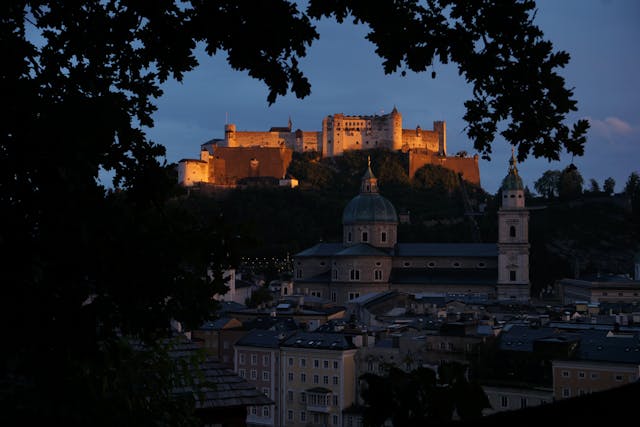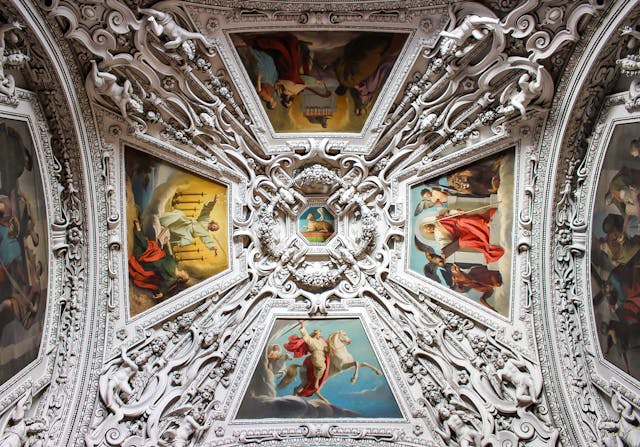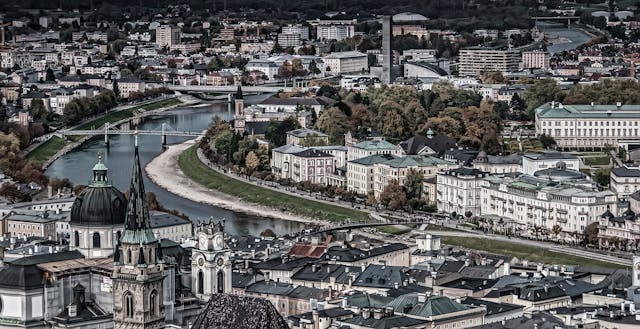Salzburg, Austria, invites visitors to explore history with every step. With its baroque facades, medieval fortresses, and cultural landmarks, the city offers more than scenery. Its past is preserved not only in museums, but in spaces people still use today. That’s why so many travelers look for the best historical sites to visit in Salzburg before their trip.
Perfect Stop if You Are Taking a Road Trip Across Europe
If you enjoy planning long drives and spontaneous detours, Salzburg is an easy and rewarding addition to your route. The city sits along popular travel paths connecting Germany, Italy, and the Czech Republic. Many tourists add a few nights here if they are taking a road trip across Europe, because it offers such a strong concentration of historical and cultural attractions. Unlike larger cities, Salzburg is compact, walkable, and full of scenic viewpoints, so you can enjoy a lot without feeling rushed.
Mozart’s Birthplace Is a Living Tribute
Few musicians shaped global culture the way Mozart did, and Salzburg celebrates his legacy proudly. His birthplace on Getreidegasse is now a museum filled with family letters, portraits, and childhood instruments. Exhibits offer a close-up view of Mozart’s early life and the social conditions that fueled his genius. A visit here connects you not only to the man but also to Salzburg’s role in European music history. It’s a must-see for classical music fans.
A City That Americans Love to Call Home
Salzburg’s reputation goes beyond tourism. It ranks among the top cities that Americans love to call home. With its clean streets, friendly pace, and mix of outdoor and cultural activities, the city appeals to families, retirees, and digital nomads alike. Many American expats cite the affordability and lifestyle quality as key reasons to settle here. Historical neighborhoods like the Old Town offer character that’s hard to match in modern cities, and everyday walks often include castles, fountains, and baroque facades.
Hohensalzburg Fortress Watches Over the City
Towering over Salzburg’s rooftops is the Hohensalzburg Fortress, a 900-year-old stronghold that dominates the skyline. Once used to protect archbishops during times of conflict, the fortress is now one of the best-preserved in Europe. Visitors can ride a funicular or take a steep hike to the top. Inside, you’ll find medieval rooms, torture chambers, and panoramic terraces that showcase Salzburg’s winding streets and distant Alps. It’s an unbeatable introduction to the city’s long and layered past.

Mirabell Palace Combines Beauty and History
Built by Prince-Archbishop Wolf Dietrich as a gift for his beloved, Mirabell Palace blends romance with opulence. Its gardens, statues, and walkways reflect formal baroque design, while the Marble Hall is used for weddings and concerts today. Walking through Mirabell gives you a sense of how Salzburg’s ruling class lived and entertained. And if you’re traveling with kids, the dwarf statues and maze add some fun to your cultural outing.
Old-World Peace at St. Peter’s Abbey and Cemetery
Tucked behind the cathedral, St. Peter’s Abbey is one of the oldest monasteries in the German-speaking world. The church and library are impressive, but many visitors come for the adjacent cemetery. Here, ivy-covered tombs and carved stone walkways tell stories of Salzburg’s noble families. Carved catacombs in the cliffside give you a glimpse into early Christian worship. You can feel the passage of time in every quiet corner.
Don’t Miss the Festivities of the Feast of St. Rupert
Each September, Salzburg honors its founding bishop with music, food, parades, and traditional dress. The Feast of St. Rupert brings history to life in a fun and public way. The main squares turn into festive marketplaces, and historic sites become stages for cultural expression. Visitors during this time can enjoy church tours, craft booths, and local dances all around the historical center. It’s one of the best times to connect with the city’s living traditions.
Visit the Residenz to See Archbishops’ Power Up Close
The Residenz was home to Salzburg’s prince-archbishops for centuries. The luxurious rooms, formal galleries, and lavish decorations demonstrate the immense power these rulers wielded—not just spiritually, but also politically. The Residenz also hosts a fine art gallery featuring works from the 16th to 19th centuries. Guided tours explain how these religious leaders shaped the city, from building infrastructure to sponsoring music and art.
Hellbrunn Palace and Trick Fountains: A Playful Stop Among the Top Historical Sites to Visit in Salzburg
Built in the early 1600s as a summer residence, Hellbrunn Palace is unlike most historical homes. It’s famous for its water-powered “trick fountains,” which still surprise guests today. Grottoes, mechanical theaters, and water features line the garden walkways, making this site a favorite for families. The palace’s design and features reveal how leisure and technology were interwoven during the Renaissance.
Salzburg Cathedral Offers Sacred Art and Architecture
This grand baroque cathedral dominates the Domplatz and reflects over a thousand years of architectural evolution. Inside, you’ll find massive pipe organs, marble altars, and the font where Mozart was baptized. Fire destroyed previous versions of the cathedral, and its reconstruction tells a story of resilience and change. The peaceful interior contrasts with the lively squares outside, giving visitors a moment to reflect amid all the sightseeing.

European Adventures Await at Nonnberg Abbey
Set on a peaceful hillside, Nonnberg Abbey is an active Benedictine convent with roots going back over 1,300 years. It became famous thanks to “The Sound of Music,” but its true significance lies in its enduring spiritual presence. Visitors can attend early morning mass or quietly explore the chapel and surrounding paths. The abbey feels like a pause in time, reminding travelers that European adventures await beyond major landmarks and guided tours.
Quiet Reflection at the Capuchin Monastery
Just across the river, this modest monastery provides stunning views of the Old Town. A forest trail leads to it, with religious shrines placed along the route. Once there, you’ll find simple architecture, open courtyards, and a chance to look back at the city you’ve explored. It’s a good way to end your historical tour, offering peace and reflection after the visual intensity of Salzburg’s baroque center.
Why Salzburg’s History Feels Personal
Salzburg doesn’t overwhelm visitors with plaques or timelines. Instead, it draws you into its history through active spaces, music, architecture, and traditions. You learn by walking, listening, and participating. The mix of preserved buildings and active use makes each site feel relevant, not frozen. It’s this connection between past and present that defines the unique charm of the many Historical Sites to visit in Salzburg, Austria, and makes the city so memorable.
A City That Lives Through Its Landmarks
Visiting the historical sites in Salzburg, Austria, is more than ticking boxes on a travel checklist. Each place contributes something different—a piece of culture, a personal story, or a shift in perspective. From fortress walls to silent abbeys, the city gives you many ways to experience time. Whether you’re traveling through Europe for a week or settling in for a new life abroad, Salzburg’s historic charm will stay with you. And you’ll likely find yourself planning a return visit before you’ve even left.
About the author:
Sarah Bellamy is a travel writer passionate about European history, cultural landmarks, and local traditions. She enjoys helping readers plan meaningful trips by highlighting destinations rich in heritage. When she’s not writing, you’ll find her exploring cobblestone streets and hidden courtyards across the continent.
